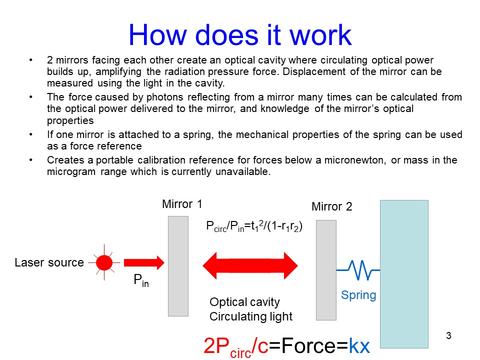Problem
A mechanical sensor incorporating an optical cavity is used to provide a mass and/or force reference from a known or characterized circulating optical power in the optical cavity. The radiation pressure force in the optical cavity is used to actuate the mechanical sensor. The optical cavity in put laser power can be multiplied by a factor equal to the cavity finesse to determine the cavity circulating power, with the photon pressure force also increasing by a factor equal to the cavity finesse. The sensor is compact with all optics designed to be self-aligning and optical mode selective. The sensor mechanics are designed to yield a highly directional mechanical force for mass or force calibration over a wide frequency range, allowing for both dynamic and static force measurement.

Invention
An optomechanical reference includes a basal member; a flexure that includes: a floating link; a first flexural member; and a second flexural member such that: the floating link is moveably disposed; a first stator; a second stator; a first cavity including: a first primary mirror; a first secondary mirror; a first optical coupler in optical communication with the first secondary mirror; and a first cavity length; and a second cavity including: a second primary mirror; a second secondary mirror; a second optical coupler; and a second cavity length.
Features
The availability of a calibration reference in the sensor is advantageous over other techniques which require periodic calibration offsite. In addition, the sensor mechanical properties can be engineered to cover a wide range of force and mass.

